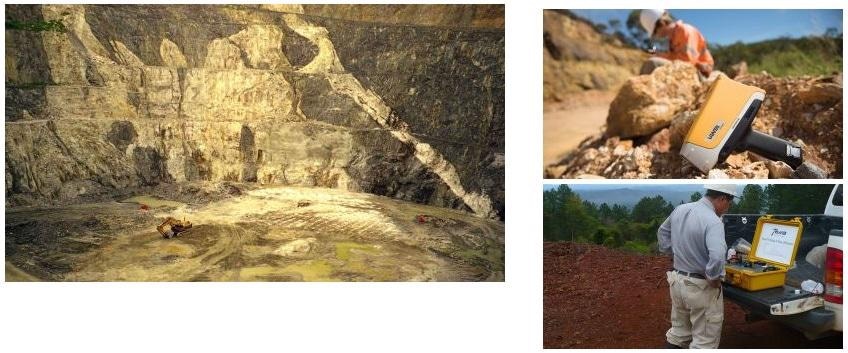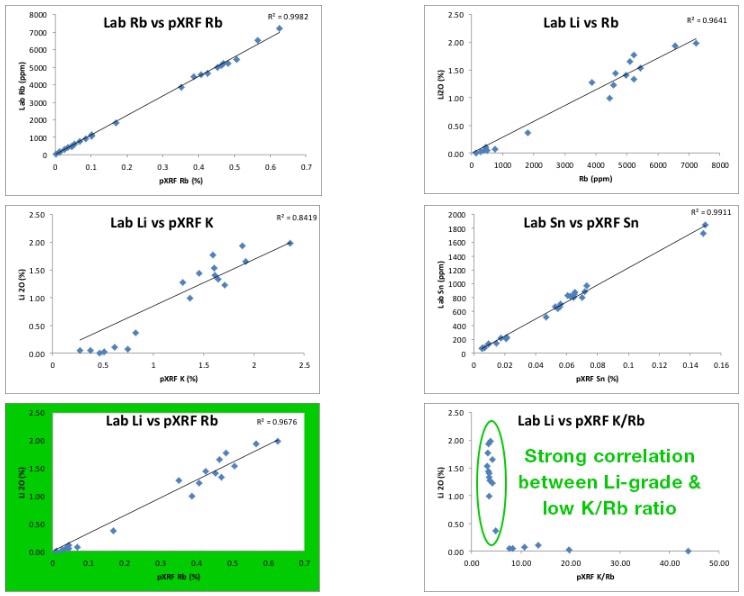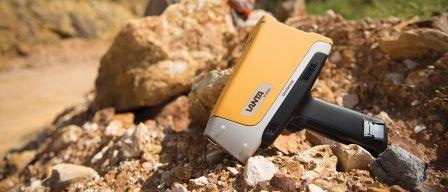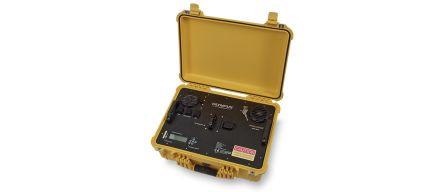Techniques such as portable X-ray diffraction (pXRD) and portable X-ray fluorescence (pXRF) are considered as indispensable tools in the exploration and analysis of lithium-bearing mineral deposits.
Globally, lithium production is currently derived from two major deposit types: (1) lithium brines or salars and (2) lithium-bearing pegmatites, with universal output divided about 50:50 from every source. This article focuses on lithium-bearing pegmatites and shows how the Evident pXRF and pXRD analyzers are applied to these kinds of deposits.

Figure 1. The world-class Greenbushes Li-Ta-Sn LCT pegmatite in Western Australia; an Evident Vanta™ portable XRF analyzer used for geochemical mineral exploration (upper right); an Evident TERRA® portable XRD for mineralogy (lower right).
Exploration for LCT Pegmatites
The late-stage fractionation and emplacement of fertile, peraluminous granites result in the formation of lithium-bearing pegmatites, that is, plutonic rocks. These rocks are usually known as lithium-cesium-tantalum (LCT) pegmatites because of the enrichment in the incompatible elements of tantalum, rubidium, tin, cesium, and lithium. This diagnostic set of elements distinguishes LCT pegmatites from other rare-element pegmatites, such as niobium-yttrium-fluorine (NYF). Moreover, LCT pegmatites are often enriched in fluxing components, such as water, boron, phosphorus, and fluorine, and this can be clearly seen in their extraordinary mineralogical and geochemical make-up.
Mineralogically, an assemblage of K-feldspar + quartz + muscovite + albite dominates LCT pegmatites, which are generally zoned with the fractioned and more evolved phases like lepidolite (Li), spodumene (Li), tantalite-columbite (Ta-Nb), petalite (Li), apatite (P), cassiterite (Sn), garnets, tourmaline (B), and beryl (Be) that occur inside the inner core zones as well as margins.
Portable XRF and LCT Pegmatites
Due to limitations in X-ray physics, pXRF cannot be used for direct analysis of lithium; however, the newest range of instruments can be effectively used for detecting a significant range of whole rock and related pathfinder elements, such as Ca, K, Sr, Rb, Nb, Y, Cs, Sn, Sb, Ta, Bi, W, Tl, Ga, As, and also the rare earth elements (REEs) of Ce and La. A majority of these elements relate to high field strength elements (HFSE) and group 1 alkali metals on the periodic table.
Trueman and Cerny (1982) completed a study that elucidates several correlations used for differentiating rare metal-bearing pegmatites from barren pegmatites, such as the application of K/Rb ratios, in which K is substituted by Rb in feldspar and micas during late-stage crystallization. The team observed that a K/Rb of 160 denotes increasing fractionation, and a ratio of corresponds to highly fractioned pegmatites typically composed of rare metal mineralization, especially Li, Ta, Cs, Be, and Nb. This is shown in Figure 2, which includes sample data obtained from an LCT pegmatite deposit in Southeast Asia, with excellent agreement between the pXRF and laboratory for major elements.

Figure 2. Lab and pXRF data on lab-pulps from an LCT pegmatite deposit, showing excellent agreement between (a) lab Rb and pXRF Rb, (b) lab Sn and pXRF Sn, (c) lab Li vs Rb, (d) lab Li vs pXRF Rb, (e) lab Li vs pXRF K, and (f) lab Li vs pXRF K/Rb. Data courtesy of Argo Metals Group from an LCT pegmatite project in SE Asia.
It must be remembered that good sample preparation and presentation is important to achieve equally good and consistent results because of the highly coarse-grained nature of pegmatites. Therefore, taking this factor into consideration, pXRF can be used for:
- Differentiating rare metal-bearing pegmatites from more typical and barren pegmatites having granitic composition and for differentiating LCT-pegmatites from NYF-pegmatites.
- Identifying and assessing the fertility of granitic parent rocks in relation to hosting potential of LCT pegmatites. When compared to standard granites, fertile granites have increased amounts of Cs, Rb, Ta, and Sn, and also lower K/Rb ratios.
- Direct analysis of drilling cuttings, outcrop, and surface soil samples. Specifically, metals like As, Sb, and Sn can be effectively used for mapping out surface anomalies where Rb, K, Cs, and Li have been either mobilized or depleted, or both.
- As a proxy for lithium grade, where there is a robust correlation with pathfinder elements, especially Rb, which has been established by an in-depth orientation survey with adequate quality lab data (illustrated in Figure 2).
- Immobile trace elements (like Zr and Ti) and entire rock chemistry (such as Al, Fe, Mg, Ca, K, and Si) for litho-geochemistry to establish pegmatite zonation, deposit stratigraphy, and alteration.
Portable XRD and LCT Pegmatites
The LCT pegmatites’ mineralogy can be quite complicated and a better understanding of the lithium-bearing phases is believed to be equally significant as the lithium grade when scoping the feasibility of a project. This is attributed to the difficulty involved in extraction, processing, and liberation of certain phases and lithium-micas, to be specific. The major lithium-bearing minerals are summarized in Table 1.
Table 1. Main Lithium-bearing minerals and chemistry
| Mineral Name |
Li2O (%) * |
Chemical Formula |
| Spodumene |
8.03 |
LiAl(SiO3)2 |
| Petalite |
4.50 |
LiAlSi4O10 |
| Eucryptite |
11.86 |
LiAlSiO4 |
| Amblygonite |
7.40 |
(Li,Na) AlPO4(F,OH) |
| Lepidolite |
7.70 |
K(Li,Al)3(Al,Si)4O10(F,OH)2 |
| Lithiophilite |
9.53 |
LiMnPO4 |
| Zinnwaldite |
3.42 |
KLiFeAl(AlSi3)O10(OH,F)2 |
| Holmquisite |
3.98 |
Li2(Mg,Fe2+)3Al2Si8O22 (OH)2 |
| Triphylite |
9.47 |
Li(Fe,Mn)PO4 |
Source: webmineral.com
The Evident portable XRD (pXRD) technology enables a low-cost and rapid quantitative mineralogy without necessitating considerable sample preparation to give a complete understanding of the pegmatite mineralogy. Once robust quantification has been completed, the technology can also be used for back-calculating lithium grade.
Products Used for This Application
Vanta for Mining and Geochemistry
The Vanta handheld XRF analyzers designed for geochemistry and mining offer instant on-site elemental analysis for ore processing, remediation, mining grade control, and geochemical exploration.

TERRA Mobile XRD System
The TERRA Mobile XRD System is a battery-operated, high-performing, fully contained, closed-beam portable instrument that allows full phase identification of trace, minor, and major components with a rapid XRF scan of elements from calcium to uranium. Fast, in-field analysis can be achieved, thanks to its sample chamber and exclusive, minimal sample preparation method.

Reference
Trueman, D. Cerny, P. 1982 Exploration for Rare–element Granitic Pegmatites in Granitic Pegmatites in Science and Industry. Ed. P. Cerny. Min. Assoc. of Canada. pp 463–494.

This information has been sourced, reviewed and adapted from materials provided by Evident (XRF / XRD).
For more information on this source, please visit Evident Industrial (XRF).